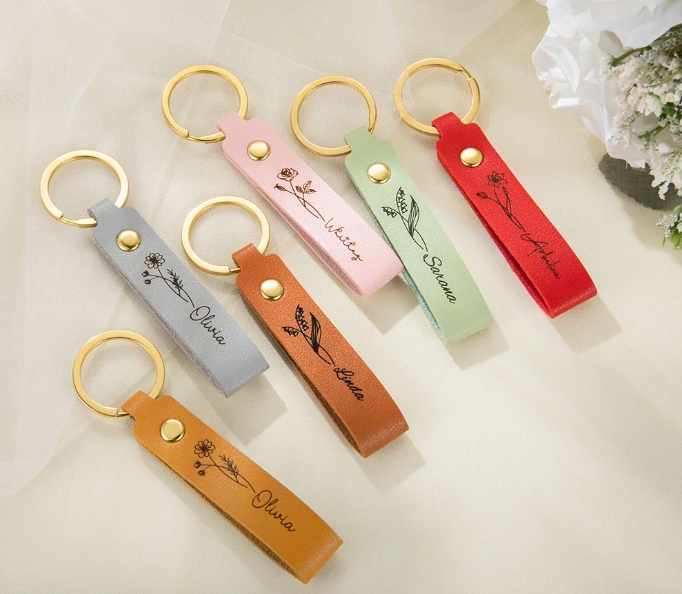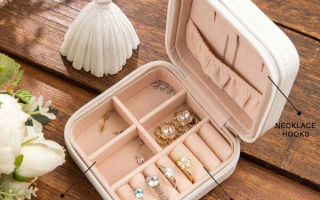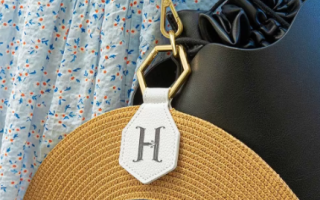As a craft, the leather keychain is a practical accessory and an avenue for portraying oneself.
However, it might be hard to accomplish this if you need to know where to start or what to do. But you also need to see the design to go for and why.
Luckily, this piece will cover everything about making a leather keychain; by the end, you’ll know how to get started.
Materials and Tools Needed
Suitable materials such as leather and high-quality hardware with the necessary tools will provide a basis for a successful and rewarding crafting enterprise.
Here, we’ll take you through the basics and tools you can use to get your dream leather keychain.
Materials
When choosing these materials, consider your preferences and what the keychain will be used for.
With a list of transparent materials, let us move to the critical tools required to create this leather keychain.
- Leather: It is essential to select the correct type of leather for a quality keychain. Choose a leather thickness that matches your design and taste. Some popular options include full-grain, top-grain, or vegetable-tanned leather.
- Keyring or Clasp: Choose a strong keyring or clasp that will keep your keys safe. This is available in different shapes and forms, so select one that suits the overall design of the keychain.
- Rivets or Leather Glue (Depending on Design): The choice between rivets and leather glue depends on your design and desired permanence.
- Optional: If Required, Dye or Paint for Leather: Consider using leather dye or paint for a splash of brightness or additional personalization. The optional stage lets one be artistic and personalize the leather’s key chain.
Tools
Having such valuable tools at your disposal will make leather crafting more enjoyable and contribute to implementing a high level of professional results.
- Leather Cutter or Sharp Scissors: Ensure that you have a reliable leather cutter or a pair of sharp scissors for high precision when cutting your leather. The clean and precise cut will help achieve the appearance of a professional keychain.
- Hole Punch Suitable for Leather: A leather punch of high quality that provides clean and evenly spaced holes is necessary. This tool is essential for fastening hardware such as key rings or closures.
- Rivet Setter: However, if you choose rivets to be part of your design, you will need a rivet setter to help install them. This tool allows a secure fit and gives a professional look to your leather keychain.
- Hammer (for Rivets): A light hammer is necessary for working with rivets. It does make the rivets properly without causing any damage to the leather. Ensure it is adequate for the rivet size you’re using.
- Ruler or Measuring Tape: Correct measurements are essential for creating a reasonable keychain. Ensure a ruler or measuring tape is handy during the cutting and assembly stages to avoid inaccuracies.
- Pen or Chalk for Marking: Importantly, marking the leather is essential for proper cutting and hole punching. A pen or chalk will help you trace your design work, keep hole placement, and direct through the craft stage.
Choosing Your Leather
When setting out to make your leather keychain, one of the most important considerations will be to choose the needed leather.
The kind of leather, its thickness, and its quality will not only affect the usability of the keychain in terms of its durability, but they will contribute in a not-inconsiderable measure to its looks.
1. Consider Leather Thickness
Your keychain’s overall durability and appearance will depend on the thickness of the leather that you will pick.
Thick leathers are appropriate for durable and solid keychains, while the thinner alternatives create more delicate and flexible designs.
Think about the purpose for which the keychain is being used and choose an appropriate thickness according to your taste.
2. Explore Different Leather Types
Different types of leather come with unique features; you must familiarize yourself with them to know the kind of leather you need.
This is due to its inherent natural markings and durability, while top-grain leather provides a more polished, smooth surface generation.
Vegetable-tanned leather offers a wide range of options for finishing by dyeing and molding.
Check these alternatives out to determine what type of leather is most suitable for your dreamed essential chain shape.
3. Evaluate Aesthetic Appeal
The design attractiveness of your keychain plays a significant role depending on the kind of leather that you choose.
Full-grain leather tends to attain a wonderful patina with age, thus giving your project depth and individuality.
Vegetable-tanned leather allows creative people to develop their designs through dyeing or painting.
Consider the style you would like your keychain to have and choose the type of leather that reflects your personality.
4. Think About Longevity
Opt for high-quality leather material that can withstand daily demands if longevity is questioned.
Although they might be costly initially, high-quality leather ensures that your keychain ages beautifully and keeps its beauty in the long run.
Consider the intended purpose of the keychain and select a leather material that corresponds to your perceptions of service life and workability.
Designing Your Keychain
Having chosen the perfect leather for your keychain, the next creative move is to create a personalized masterpiece.
Designing your keychain offers you the elegance of engraving a part of your personality.
1. Check Shapes and Sizes
The shape and size of your keychain can also significantly affect its appearance and practicality.
Experiment with rectangles, circles, or custom shapes representing something important to you.
Choose a size that suits your needs – whether you like a small, minimalist design or a bigger one that catches the eye.
2. Personalize Through Embossing, Stamping, or Painting
Develop the aesthetics of your personalized keychain through embossing, stamping, or painting.
Embossing and stamping enable you to stamp designs, initials, or symbols onto the leather, creating a unique and personalized feature.
However, if you want to give your keychain some vibrant colors and a specific design that will make it unique, you can use leather paint or dye.
3. Plan Your Design: Sketching and Dimensions
Before you go into the making process, you should plan your design. Outline your concepts on the paper in terms of proportions and dimensions.
Planning the initial stages gives you an understanding of the final product and ensures that your keychain turns out as per your imagination.
Consider positioning the holes in the hardware and any other features you want to install.
Cutting and Shaping the Leather
After drawing your design carefully, it’s time to turn it into reality by cutting and forming the reluctant leather into the desired shape.
This particular step is essential; it must be done with precision and total concentration to turn out just how you imagined your keychain.
- Prepare Your Workspace: Create a workspace that is clean, well-lighted, and there is enough space for your materials and tools.
- Transfer Your Design: Place the design template on the leather and mark the template out for dimension, using a ruler as your guide. Trace the design outline onto the leather using a pen or chalk.
- Cut the Outline: To achieve this, use a sharp knife or a pair of leather cutters or scissors and cut along the traced shape, focusing on details and ensuring clean, even cuts.
- Fine-tune the Edges: Look at the perimeter of the piece for any anomalies and use the cutter or scissors to finish the edges to a fine and smooth finish.
- Punch Holes if Necessary: If your design needs holes where to accommodate hardware, punch holes through the marked areas using an appropriate hole punch.
- Double-Check Dimensions: Make sure the cut leather fits the dimensions and overall form you initially sketched.
Adding Color and Texture (Optional)
This means that you can now apply colors and textures to this leather key chain to create the right effect and make it sleeker than it usually looks.
This optional stage presents an excellent avenue for creating a creative and innovative touch on your central piece.
- Embossing or Stamping: Alternatively, sharpen your keychain’s textures through engraving and embossing for unique patterns or symbols.
- Leather Dye or Paint: Add color to leather with leather dye or paint, layers applied only thinly to naturally realistic or vividly artificial looks.
- Texture Through Tooling: With leatherworking tools, you may mix detailed textures and patterns, thus transforming your keychain into a deeper belle lector.
- Consider Natural Aging: Allow the patina that naturally forms on the chain to let it age into how it has to look.
Assembling the Keychain
You must now assemble your keychain with the ready-to-use leather piece you have carefully cut and formatted.
This segment will walk you through the process of incorporating hardware, securing the hardware, and making sure the customized keychain looks good.
It is displayed in terms of performance but, at the same time, durable.
Attaching the Hardware
The right approach to assembling your keychain is precision and attaching hardware to deliver style and make a statement.
Attach the keyring or clasp cautiously, as the bag is designed for full use, ensuring the critical ring or clasp remains the same.
Regarding rivets or for a crafty look, rivets are more challenging to wear but may take time to apply.
Choose between the timeless and robust option of rivets or opt for a quick and effective bond with leather glue for a streamlined look.
Whether it is a method you opt for, the deciding factor should complement your design preferences so that your work is responsible for an attractive, long-lasting keychain that reflects your individuality.
Finishing Touches
After looking for a final touch, you have almost completed your leather keychain. Make the edges of the rough even to get a neat look and increase the smooth feel.
Secondly, the leather should be ‘broken in’ to maintain its softness and protect it from wear.
These steps, although simple but essential, add an enduring touch of quality to your keychain, which does not only smile but can withstand trials and tribulations.
Customization Ideas
Since you have gotten the hang of making leather keychain basics, it is time to explore creative ways of personalizing your keychain and making it unique.
Initials, Symbols, or Unique Designs
Customize your keychain using initials, personal symbols, or inventive patterns. Emboss the surface of the leather using embossing tools or stamps to imprint letters or symbols.
Not only does this personalize it, but it also makes it a keepsake.
Incorporating Other Materials
Move your customization one step further by combining leather with other materials. Incorporate a metal charm that reflects your interests or hobbies to make the keychain attractive and textured.
Besides that, you can add wooden beads onto the keyring to add a natural and rustic look to the design.
Colorful Accents with Thread or Cord
Use thread or cord to add vibrant and colorful accents to your crucial chain.
Thread them through punched holes or wrap them around particular areas for a playful and fascinating result. Play with colors and designs to suit your preferences, and get a statement necklace.
Caring for Your Leather Keychain
You must take care of it a little when you walk with your personalized leather key chain, making it long-lasting and attractive.
This section gives valuable tips on how to follow these four bullet points for effective care:
Regular Cleaning
Wipe your leather keychain with a soft, damp cloth now and then to maintain its luster. Gently clean the surface of any dirt or impurities to prevent it from peeling and ruining the look of the leather.
Conditioning for Suppleness
Refrain from ruining the suppleness and continuity of the leather by not using a leather conditioner.
Not only does this maintain the material’s flexibility, but it also helps to prevent cracks and drying. Ensure you are using the right conditioner according to your leather.
Avoiding Excessive Moisture
Key chains made of leather are prone to the damage that may occur in excess moisture, and you should not expose your keychain to water.
If it does get wet, wipe it with a soft cloth and let it air dry correctly. However, do not use heat sources such as hair dryers because they tend to strip the leather of its natural oils.
Protecting from Sunlight and Heat
Ensure a longer life for your leather keychain by safeguarding it from extended exposure to sunlight and heat.
Keep it in a cool and dry place when you are not using it because direct sunlight and high temperatures may result in leather fading and brittleness as time passes.
Conclusion
So, at the end of your personalized journey in making a leather keychain, let the sense of creativity and originality guide you further.
Feel free to experiment with different designs, patterns, and shades, allowing each keychain to represent your individuality.
The fulfillment of creating something manually is not limited to the functionality of a keychain; instead, it is the embodiment of your creativity and ability to create what has been produced.
You can also get a Personalised Birth Flower Leather Keychain that’s durable and helps solve all your dilemmas.




